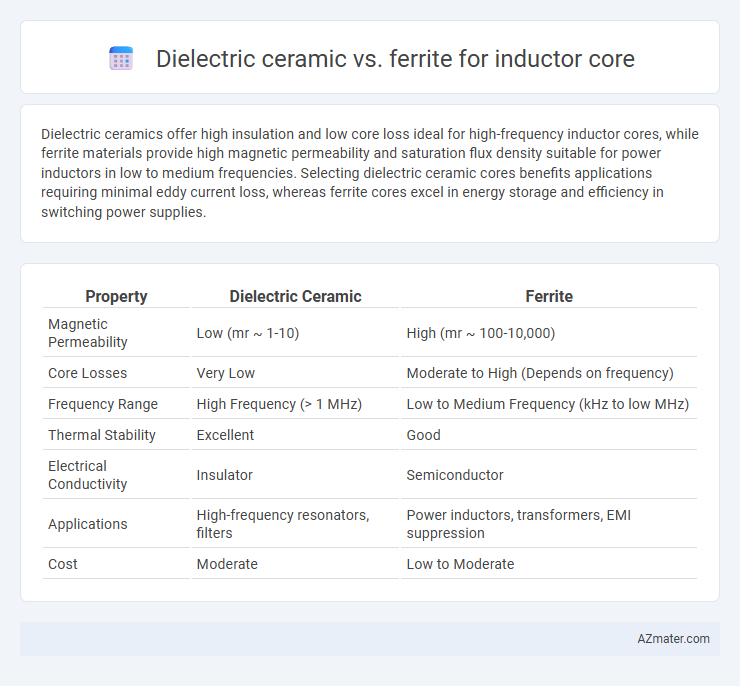Dielectric ceramics offer high insulation and low core loss ideal for high-frequency inductor cores, while ferrite materials provide high magnetic permeability and saturation flux density suitable for power inductors in low to medium frequencies. Selecting dielectric ceramic cores benefits applications requiring minimal eddy current loss, whereas ferrite cores excel in energy storage and efficiency in switching power supplies.
Table of Comparison
| Property | Dielectric Ceramic | Ferrite |
|---|---|---|
| Magnetic Permeability | Low (mr ~ 1-10) | High (mr ~ 100-10,000) |
| Core Losses | Very Low | Moderate to High (Depends on frequency) |
| Frequency Range | High Frequency (> 1 MHz) | Low to Medium Frequency (kHz to low MHz) |
| Thermal Stability | Excellent | Good |
| Electrical Conductivity | Insulator | Semiconductor |
| Applications | High-frequency resonators, filters | Power inductors, transformers, EMI suppression |
| Cost | Moderate | Low to Moderate |
Introduction to Inductor Core Materials
Dielectric ceramic and ferrite materials serve distinct roles in inductor cores, influencing performance attributes such as permeability, frequency response, and core losses. Ferrite cores exhibit high magnetic permeability and low eddy current losses, making them ideal for high-frequency applications like power inductors and transformers. Dielectric ceramic cores, characterized by their insulating properties and high dielectric strength, are primarily used in capacitive elements but can be applied in certain inductive components where low magnetic loss and specific frequency characteristics are required.
Overview of Dielectric Ceramic Inductor Cores
Dielectric ceramic inductor cores offer high dielectric constants and low loss tangents, enabling compact inductors with stable performance at high frequencies. These cores provide excellent temperature stability and reduced eddy current losses compared to ferrite cores, making them ideal for RF and microwave applications. Their inherently high resistivity minimizes core losses, enhancing overall efficiency in sensitive electronic circuits.
Overview of Ferrite Inductor Cores
Ferrite inductor cores offer high magnetic permeability and low core losses at high frequencies, making them ideal for RF and power applications. These cores, typically composed of iron oxide combined with other metal oxides, provide excellent efficiency in inductors by minimizing eddy current losses and maintaining stable inductance under varying temperatures. Ferrite cores outperform dielectric ceramic alternatives in frequency response and magnetic properties, making them a preferred choice in compact, high-frequency inductors.
Magnetic Properties: Dielectric Ceramic vs Ferrite
Ferrite cores exhibit high magnetic permeability and low magnetic losses, making them ideal for inductors operating at high frequencies and providing strong magnetic coupling. Dielectric ceramic cores, typically used for their excellent electrical insulation and low dielectric loss, have significantly lower magnetic permeability and are less effective in concentrating magnetic flux. The magnetic properties of ferrite, including a high Curie temperature and superior saturation magnetization, outperform dielectric ceramics in inductor core applications requiring efficient magnetic energy storage and minimal core losses.
Frequency Response Comparison
Dielectric ceramic cores exhibit superior high-frequency performance due to their low core losses and stable permittivity, enabling inductors to operate efficiently above 100 MHz. Ferrite cores perform optimally in the MHz range but suffer increased losses and reduced permeability at higher frequencies, limiting their effectiveness beyond tens of MHz. Therefore, dielectric ceramic inductors are preferred for applications requiring high Q-factors and minimal energy dissipation at ultra-high frequencies.
Core Losses and Efficiency
Dielectric ceramic inductors exhibit significantly lower core losses compared to ferrite cores, especially at higher frequencies, enhancing overall efficiency in high-frequency applications. Ferrite cores generally have higher core losses due to greater hysteresis and eddy current effects, which can reduce the inductor's efficiency under demanding operating conditions. Selecting dielectric ceramic cores results in improved energy efficiency, reduced heat generation, and better performance stability in power electronics and RF circuits.
Thermal Stability and Temperature Performance
Dielectric ceramic cores exhibit superior thermal stability with low temperature coefficients, maintaining consistent inductance across wide temperature ranges suitable for high-frequency applications. Ferrite cores demonstrate moderate thermal stability but can suffer from significant permeability variations and core losses at elevated temperatures, impacting temperature performance in power inductors. Dielectric ceramics are preferred in environments requiring precise inductance and minimal thermal drift, while ferrites are valued for cost-effectiveness and high magnetic permeability in less thermally demanding conditions.
Size and Manufacturing Considerations
Dielectric ceramic cores offer smaller sizes and higher Q factors compared to ferrite cores, making them suitable for compact, high-frequency inductors. Ferrite cores are easier to manufacture in bulk with cost-effective processes and exhibit better performance at lower frequencies due to their magnetic properties. The choice between dielectric ceramic and ferrite cores depends on balancing miniaturization needs with manufacturing scalability and operating frequency.
Application Suitability: Where Each Core Excels
Dielectric ceramic cores excel in high-frequency applications such as RF circuits and microwave devices due to their low dielectric loss and stable permittivity. Ferrite cores are ideal for power inductors, transformers, and EMI suppression in lower frequency ranges because of their high magnetic permeability and low eddy current losses. Dielectric ceramics provide superior insulation and thermal stability, while ferrites offer better magnetic performance in power conversion and signal filtering.
Summary: Choosing the Right Inductor Core Material
Dielectric ceramic cores offer high insulation resistance and low core loss, making them ideal for high-frequency, low-power inductors, while ferrite cores provide higher magnetic permeability and saturation flux density suited for power inductors and EMI suppression. Ferrite materials typically support frequencies from a few kHz up to hundreds of MHz, whereas dielectric ceramics are better optimized for GHz ranges due to their low dielectric loss. Selecting the right core depends on the application's frequency, power handling requirements, magnetic properties, and thermal stability to ensure optimal inductor performance.

Infographic: Dielectric ceramic vs Ferrite for Inductor core
 azmater.com
azmater.com